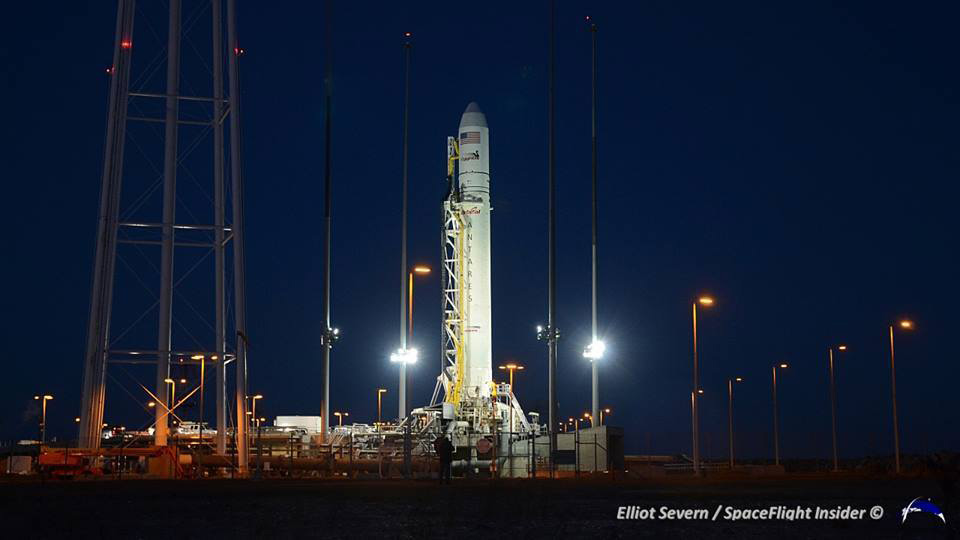January 8, 2014 8:40 pm
The Best Laid Plans, or, Space Is a Dangerous Business

Antares and Cygnus at dusk – NASA’s Wallops Flight Facility Photo by Elliot Severn of The Spaceflight Group
In the past few weeks, we’ve seen the best laid plans of Orbital Sciences and SpaceX altered by unforeseen circumstances.
Back in December, Orbital Science’s first cargo run to the ISS was postponed until astronauts could fix the station’s malfunctioning cooling system. The flight of the Antares rocket carrying the Cygnus spacecraft was rescheduled until at least January 7th… just in time for the radiation from a recent solar flare to delay the launch once again. It looks like the launch will happen tomorrow, January 9th, at 1:07 pm EST. (You can get Orbital’s mission updates here.)
In an unrelated event, last Friday’s launch of the SpaceX Falcon carrying a Thai telecommunications satellite was delayed due to a technical problem. The launch went off without a hitch Monday.
With the 28th anniversary of the explosion of the Space Shuttle Challenger later this month, on January 28th, these postponements are a reminder that while the general public can be blasé about space flight, it remains a risky business, where even the most diligent, proficient, and capable scientists and engineers can be taken by surprise by unforeseen developments.
Surprised, perhaps, but that’s usually the beginning of the story, not the end.
NASA’s Wide-field Infrared Survey Explorer (WISE) ran out of coolant for its cameras back in February of 2011, and we all thought it was done for. But in September of 2013, WISE was brought back to life as NEOWISE, focusing on Near-Earth Objects with its two cameras that don’t need coolant. (Phil Plait wrote good articles about the rebirth here and here.)
This past May, NASA’s Kepler spacecraft lost its second gyroscope-like reaction wheels. NASA said it needed 3 out of 4 of the wheels to precisely point at the mission’s field of view, to detect small Earth-sized exoplanets. Again, we all thought Kepler’s mission was over. But in November, NASA reported that a new mission, dubbed K2, would continue the search for other worlds. According to NASA, “…Kepler mission and Ball Aerospace engineers have developed an innovative way of recovering pointing stability by maneuvering the spacecraft so that the solar pressure is evenly distributed across the surfaces of the spacecraft.” As they say, necessity is the mother of invention.
Two of the most unexpected surprises are also the longest-lived ones.
On January 23rd, the Mars Opportunity Rover will conclude it’s 10th year of continuous operations on Mars, outlasting its twin rover Spirit and far exceeding the expected operational lifespan of 90 Martian days.
And Voyager 1 is still going strong, having recently taken humanity into interstellar space for the first time 36 years after it was launched, still sending back signals long after it was feared the spaceship would have gone silent.
What surprises await us in 2014? Surely, the discovery of new exoplanets. Perhaps the discovery of even older galaxies than we’ve found to date. Maybe, even, the discovery of life on Mars by Curiosity. As humanity reaches further and further out into the cosmos, by telescope or by spacecraft, nothing is certain, except perhaps, this: the universe beckons, and humanity is up for the challenge.
That’s it for now. Keep Looking Up!
–Jeffrey Simons
Get the most out of StarTalk!
Ad-Free Audio Downloads
Priority Cosmic Queries
Patreon Exclusive AMAs
Signed Books from Neil
Live Streams with Neil
Learn the Meaning of Life
...and much more

 Become a Patron
Become a Patron

